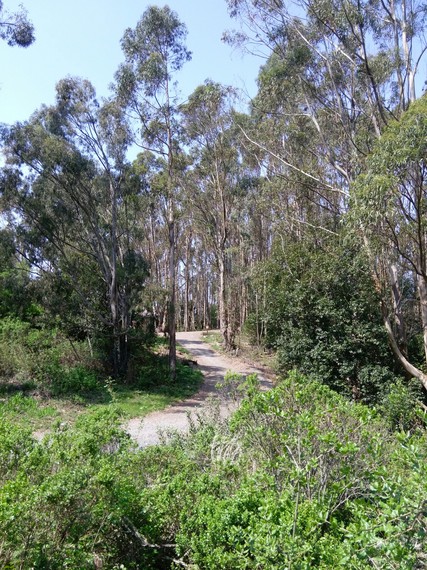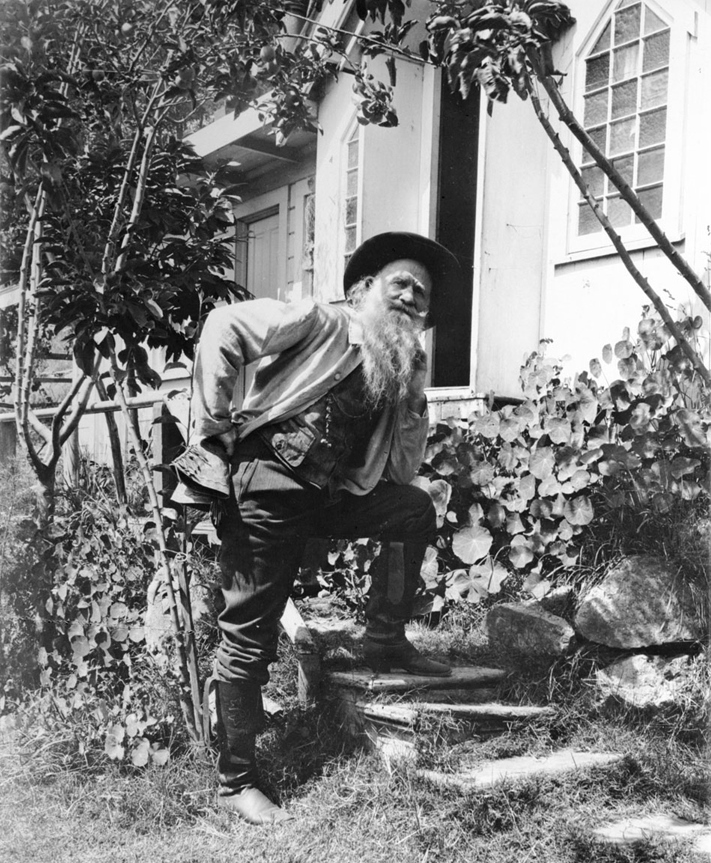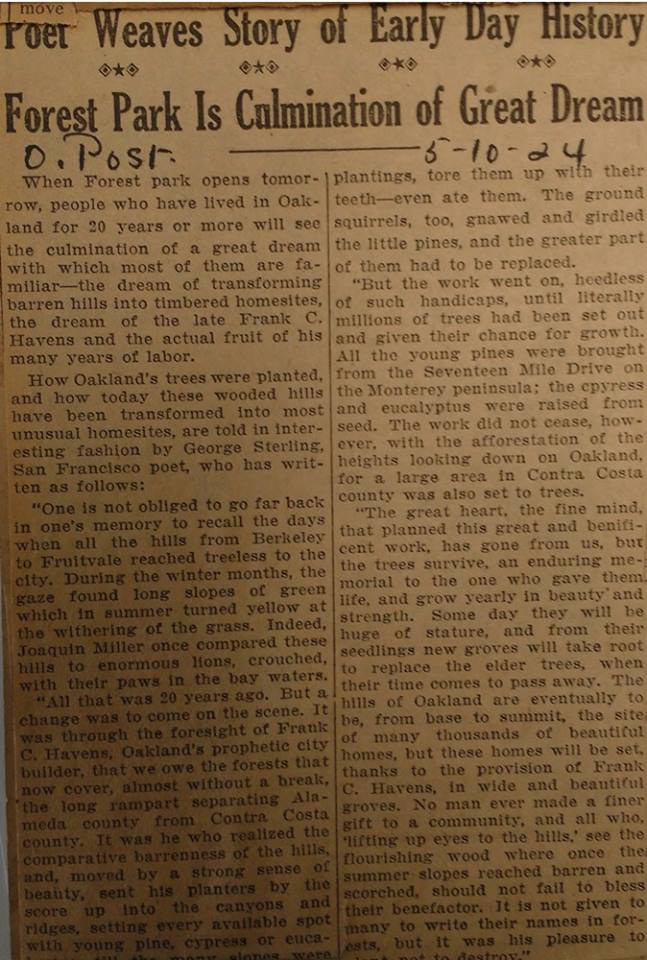By Jennifer Winograd
The most effective way to destroy people is to deny or obliterate their own understanding of their history. — George Orwell
The wrongs done to trees, wrongs of every sort, are done in the darkness of ignorance and unbelief, for when the light comes, the heart of the people is always right. — John Muir

In our work to protect the trees of the East Bay now under attack by native plant proponents, we’ve been spending a lot of time in the Oakland Library’s History Room, researching the archives which document the story of our beloved East Bay forests. It is a fascinating, rich history, one that is being both devalued and revised by those who want to destroy them, with the hope that by misrepresenting their past and the important role they play as living links to a proud, historical heritage, they might turn public opinion against those trees and in favor of their clear cutting, herbicide spreading agenda.
Indeed, our forests not only provide a multitude of benefits for those of us lucky enough to live within or near them, including great beauty, the unique and iconic natural character of our region, peaceful, shady hiking trails, animal habitat, increased property values, and fire abatement (through fog drip, windbreaks, shade, and the fire resistant nature of all living trees), they also provide a living link to a celebrated and storied past that should be recounted and revered, one that reaches back not only to the founding of the modern environmental movement, but the literary history of our region, as well; twin histories that are deeply intertwined.
Many of our region’s most famous early residents were also great naturalists, people who not only planted our forests but helped to establish the principles of conservation now under attack here in the Bay Area by the very environmental movement their ethos and efforts helped to found. Joaquin Miller, for whom an Oakland Elementary School, city park, and street are all named, was not only one of the most famous American writers of his era, known in his day as the “Poet of the Sierras” because of his great love for nature, he was also responsible for planting 70,000 trees in the Oakland park that now bears his name, a great many of them Eucalyptus which, in a great and tragic irony, the City of Oakland has been cutting down.

Miller was also the father of California’s Arbor Day, which was first celebrated here in the Oakland hills. In fact, a marker on Skyline Blvd, adjacent to the Chabot Space & Science Center, marks the historic spot, another sad irony given that this marker is now not only falling over due to neglect, but is surrounded by clear cut tree stumps. It is also located just down the road from a large section of Chabot property that the science center recently deforested at the behest of the California Native Plant Society.
Joaquin Miller was also a friend and colleague of John Muir, another lover of Eucalyptus trees who planted them on his property in Martinez and whose affection for the trees was so great, his family buried him beneath one. What brought Miller and Muir together? Their mutual respect and affection for trees – all trees — the very thing Muir’s organization, the Sierra Club, was founded, here in the Bay Area, to protect but which — in a betrayal of his vision — now advocates be clear cut by the hundreds of thousands, while poison is spread on their stumps. Were Muir alive today, he would be one of the fiercest critics of the very organization he founded.
Though some native plant groups are perpetuating the fiction that our Eucalyptus forests were planted merely for commercial lumber (a fiction which even if it were true is no reason, given all their immense benefits, to destroy them now), the historical record does not bear this out. Frank Havens, a towering figure in the history of East Oakland and Piedmont and for whom a Piedmont Elementary school is named, was a real estate developer who planted a great many Eucalyptus and Monterey Pine trees in the Oakland hills purely for beautification purposes, just as Joaquin Miller did. As a May 3, 1932 newspaper article recounts, “Havens:saw how greatly Oakland’s bare hills would be improved by trees and :planted hundreds of thousands.” Havens recognized the property value enhancing quality of trees (qualities that continue to benefit Oakland homeowners to this day) and joined in the afforestation efforts that swept through the entire state of California in the early part of last century, efforts which bequeathed to us so many of the trees, groves, and forests that now grace our state and which, thanks to their efforts, pull vast amounts of carbon from our ever-warming planet.
Havens’ plantings can be found throughout different regions of the Oakland Hills, including the Piedmont Pines and Merriewood neighborhoods, living testaments to a general passion for tree planting in Oakland that persisted well into the middle of the century and was even enthusiastically championed by politicians who sought to plant so many trees that Oakland would forever be known as the “City of Trees.” Havens tree planting efforts were a legacy celebrated upon his death by his nephew, George Sterling, another revered figure in the literary history of our region.
Sterling, known affectionately in his day as “The Uncrowned King of Bohemia,” was at the center of every artistic circle in the San Francisco Bay Area in the first part of the twentieth century. Celebrated as the embodiment of the local artistic scene, Sterling had in his time been considered one of the world’s great bards, his name carved on the walls of the Panama-Pacific International Exposition next to the great poets of the past. At times he also worked in his uncle’s real estate office, and greatly revered his uncle’s efforts to improve the region through tree plantings.

Several years after the death of his uncle, the now defunct Oakland Post published Sterling’s beautiful tribute to Havens, a tribute that recounts the role his uncle played in bequeathing to future generations of Oaklanders the beautiful, serene forests now gracing the Oakland hills:
: People who lived in Oakland for more than 20 years will see the culmination of a great dream with which most of them are familiar – the dream of transforming the barren hills into timbered homesites, the dream of the late Frank C. Havens and the actual fruit of his many years’ labor.
How Oakland’s trees were planted, and how these wooded hills have been transformed into most unusual homesites, are told in interesting fashion by George Sterling, San Francisco poet, who has written as follows:
One is not obligated to go far back in one’s memory to recall the days when all the hills from Berkeley to Fruitvale reached treeless to the city. During the winter months, the gaze found long slopes of green which in summer turned yellow at the withering of the grass. Indeed, Joaquin Miller once compared these hills to enormous lions, crouched, with their paws in the bay waters.
All that was 20 years ago. But a change was to come on the scene. It was through the foresight of Frank C. Havens, Oakland’s prophetic city builder, that we owe the forests that now cover, almost without a break, the long rampart now separating Alameda County from Contra Costa County. It was he who realized the comparative bareness of the hills, and, moved by the strong sense of beauty, sent the planters by the score up into the canyons and ridges, setting every available spot with young pine, cypress or Eucalyptus till the many slopes were clad with the rootings that have become the woods that now charm the gaze from afar, or shade the wayfarer that traverses the many valleys and heights:.
All the young pines were brought from the seventeen mile drive on the Monterey Peninsula; the cypress and Eucalyptus were raised from seed. The work did not cease, however, with the afforestation of the heights looking down on Oakland for a large area of Contra Costa County was also set to trees.
The great heart, the fine mind, that planned this beneficent work, has gone from us, but the trees survive, an enduring memorial to the one who gave them life, and grow yearly in beauty and strength.
Some day they will be huge in stature, and from their seedlings new groves will take root to replace the elder trees, when their time comes to pass away. The hills of Oakland, are eventually to be, from base to summit, the site of many thousands of beautiful homes, but these homes will be set, thanks to the provisions of Frank C. Havens, in wide and beautiful groves.
No man ever made a finer gift to a community, and all who ‘lifting up eyes to the hills,’ see the flourishing woods where once the summer slopes reached barren and scorched, should not fail to the bless their benefactor. It is not given to many to write their names in forests, but it was his pleasure to plant, not to destroy.
As environmentalists who moved to the Oakland hills precisely to live among the spectacular natural beauty created by Haven’s efforts and those of other early, tree-loving Oakland residents, we share in Sterling’s praise and count his words prophetic. For since moving here many years ago, not a day has gone by that we have not been awed by the great beauty of the soaring trees that surround us at every vista. Whether on early morning dog walks when the towering Eucalyptus tree tops appear and disappear as the quiet, gray fog snakes between their branches or, at dusk, as we drive down our hill, turn a corner, and are arrested by the breathtaking vision of a massive and stately Monterey Pine silhouetted against the bay and a setting orange sun, the deep affection we feel for the trees of the Oakland hills is now blended with gratitude for the man we are to thank for putting them there.
He is a man whose memory and efforts we pledge to honor and protect by continuing our fight against the dark, dishonest forces which now seek to revise our local history and malign his contribution in service to the dystopian agenda of native plant ideologues, an agenda that has hijacked a once noble environmental movement that can trace its very roots to the forests they now seek to destroy and to ancestors whose proud legacy they seek to obliterate.
————-
Have a comment? Join the discussion by clicking here.